- Author Miguel Ramacey [email protected].
- Public 2023-12-17 06:11.
- Last modified 2025-01-24 21:21.
Officially, Orthodoxy does not recognize amulets, but this does not mean that church relics do not help believers. Any self-respecting priest will want to cross himself at this word, as if he heard about something pagan and ungodly. But then how else to call the Orthodox cross? The amulet is the first thing that comes to mind, because it protects every Orthodox almost from birth! However, the cross is not the only religious talisman of this religion, and after reading the article, you will learn more about Orthodox amulets and their meaning. There are many prayers, but for protection from the evil eye and damage, it is best to turn to your Guardian Angel with these words:
In my prayer I turn to you, the holy Angel of Christ (name) bringing good to me.
Even you are - a hasty servant of the Almighty Creator, who reigns over all living things and all undead too.
And therefore, by the will of the Almighty, deliver me, weak and infirm, from adversitydifferent in the form of an unclean beast and other undead.
And neither the brownie, nor the goblin, nor the Pushchevik, nor the other let them destroy my soul and touch my body.
I pray you, holy Angel, for protection from evil spirits and all her servants.
Save and save by the will of the Lord God. Amen.
Origins
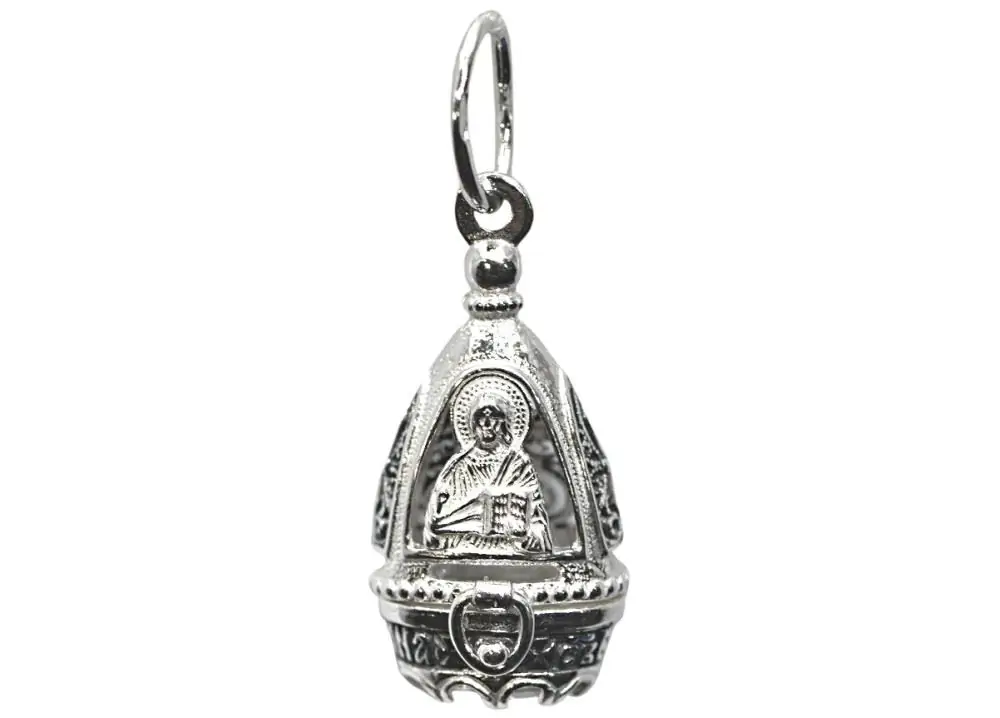
In ancient times, the inhabitants of pre-Christian Russia and other Slavic tribes kept in touch with their gods with the help of special amulets. Each talisman personified a certain element that gave a person earthly blessings: he alth, family, love, we alth or good luck. Our ancestors begged for mercy and kindness from earth, water, fire and air.
Orthodox amulets are directly related to the ancient pagan cult that existed on the territory of Russia long before its baptism. Just after the adoption of the new faith, all the masters of the elements became not dozens of wooden idols, but the only invisible God, surrounded by a host of angels and saints.
Believers know the truth - every object consecrated in the church is filled with power and is able to save from troubles. Prayers can heal any ailment and change adverse circumstances for the better.
The main Orthodox amulets are icons - the image of the Trinity (Father, Son and Holy Spirit) and other saints - who were righteous people during their lifetime, as well as angels and archangels. They were widely used back in the dark Middle Ages, when the images of Noah's Ark were worn around the neck as a symbolsafety and rescue.
At the dawn of Christianity, the Most Holy Mother of God was identified with the ancient goddesses of fertility (among the Slavs it was Makosh), who were asked to bless the family with a child, to grant prosperity, he alth, and so on. Since then, a lot of water has gone into the sand, and the Light Image has undergone some changes. Today, the icon of the Most Holy Theotokos is considered the most powerful Orthodox amulet.
Beneficial influence
Amulets are used in Orthodoxy primarily to protect yourself and your loved ones from all troubles, including illnesses or intrigues of dark forces. In addition, amulets help believers establish peace within the family, and maintain their physical or mental he alth. The power of faith works wonders, but sometimes amulets help even skeptics, who then cease to be such.
The attitude of the church towards the mascots of Christians
Officially, religion considers human fears a great sin, because God protects each of us. And if he tests someone, then you should not avoid it. An Orthodox person is not only baptized and attends the temple, but also entrusts his body and spirit into the hands of the Lord.
The clergy at all times was against various amulets, and Orthodox amulets never considered them.
The Church explains to its parishioners that wearing a pectoral cross, icon or amulet, as well as placing an icon in the “red” corner of the house, is not a means of protection from the evil one, and does not attract material well-being. After all, this is not magic or sorcery, which are ungodly (in essence) activities! Churchrelics help people to be heard by the Almighty during prayers, which are essentially a conversation with God.
Types of amulets
An Orthodox amulet that accompanies a baby almost from birth is a pectoral cross. However, someone accepts faith already at a conscious age, and receives it from the priest. The main rule is that under no circumstances should it be removed.
Icons are images of the faces of saints who hear every prayer addressed to them for help. It is they who ask God not to bypass the attention of a person in trouble. However, there are other amulets - panagias, rosaries and amulets.
Pectoral cross
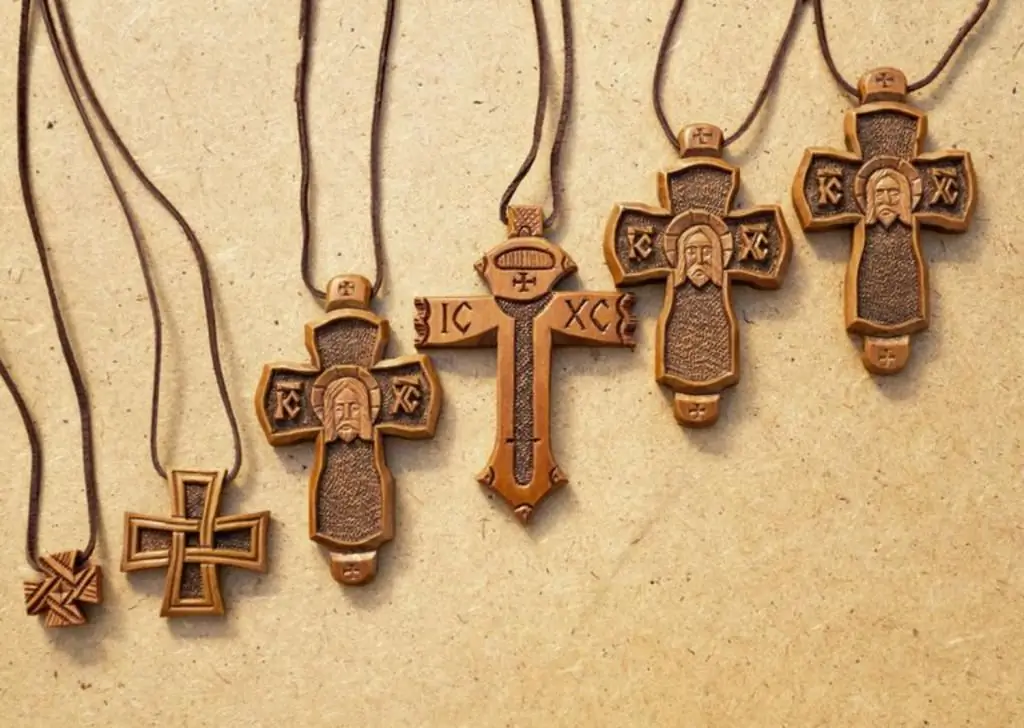
This Orthodox amulet is an ancient Christian relic. Most people consider it a means of the strongest protection against all ailments, life's adversities, and, of course, evil spirits. The pectoral cross has miraculous properties and, like knightly armor, protects the believer. This main symbol of Christianity is a reminder that Jesus was crucified for the sins of all mankind, but later resurrected and ascended alive into the Kingdom of Heaven. His fate and good deeds are an example of how to live.
Pectoral cross - a purely personal thing. It cannot be handed over to anyone, given away, or even removed. Wearing someone else's talisman implies that you have taken on someone else's sins. That is, you carry a "foreign cross." Without a doubt, from the point of view of Orthodoxy, such a rash act can radically change your life (and by no meansnot for the better). However, this rule has exceptions - a mother can give her child a cross that will always protect him.
When choosing an amulet, you need to remember that without sincere faith it will be just a beautiful "trinket" and will not have any miraculous properties. Therefore, it is so important to know the protective Orthodox prayers, and it is desirable to be able to read them. It is necessary not only to pray for help and give thanks, but also sincerely repent of your sins and be able to admit your mistakes. After all, cases are different, and no one knows around what corner the trouble is hidden. For the cross to truly become your shield against all adversity, you need to live according to the laws of God and do good deeds. That is, act according to the ten commandments.
What is an amulet?
This talisman can become a very powerful protection for its wearer, because inside you can put an Orthodox prayer - a talisman, a pinch of Jerusalem land, the ashes of a great martyr or a text from scripture. The amulet is a small box, pouch or purse, decorated with the image of Jesus Christ.
Usually, the amulet is hung on a leather cord and worn around the neck. But it can be hung on clothes by attaching it with a pin to its wrong side. It is important to follow some unspoken rules:
- The amulet must be reliably protected from dust (dirt).
- Wearing below the waist is strictly prohibited!
- Do not forget that the pin can come loose.
This amulet should be as close as possible to the body of the believer, and only then it will be possiblefeel his protection. Like other individual relics, the amulet should not know the hands of others.
Losing a talisman is an unkind sign, because with it all the protective force will go away, and the person will become vulnerable. In this case, you must definitely repent of your sins, take communion, and purchase a new amulet.
Panagia
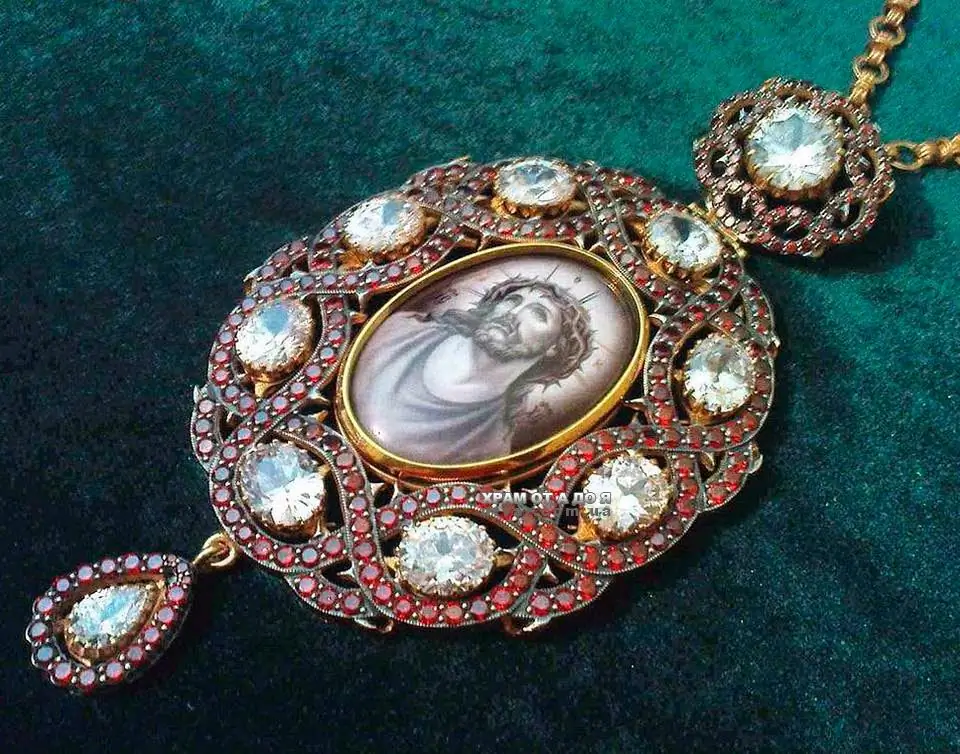
Since the birth of Christianity, encolpions have been the strongest defense against evil spirits. They were worn by both ministers of the church and ordinary believers. The word "encolpion" itself comes from Greece and translates as "to wear on the chest." In appearance, this is a small ark, on which any face of a saint revered in Orthodoxy can be applied. It is usually worn on a chain or lace, which is worn over the head.
The shape of such an Orthodox amulet can be either cruciform or rectangular (sometimes with rounded edges). Inside it is customary to put a piece of consecrated prosphora (bread) or the relics of a miracle worker saint. Such an amulet is able to protect its ward from a variety of troubles that lie in wait for each of us on the thorny path of life.
This amulet has a slightly different name - panagia, which is translated from Greek as "all-holy". The name appeared in those ancient times, when believers ate prosphora after a meal, glorifying the Mother of God. Now the panagia looks more unpretentious: it does not contain the relics of the saint inside and has a rectangular shape with rounded edges. It is worn most often by the servants of the temple.
By the way, this amulet can be worn over clothes. If you consecrate the panagia inchurch, then it turns into an Orthodox amulet from the evil eye and damage, or rather it will protect from:
- curses and slander of unkind people;
- untimely death;
- any magical influence and otherworldly evil.
Encolpion is able to heal any disease: both mental and physical. Therefore, in order for the body and spirit to be strong, it is imperative to wear a panagia, which, coupled with faith, can work miracles.
Prayer beads
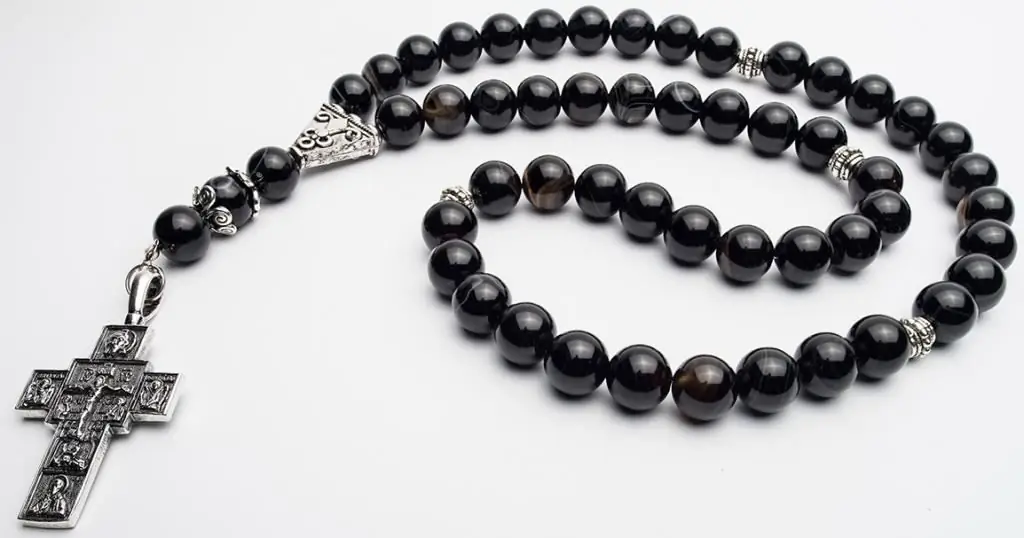
This amulet once replaced the stones with which the monks counted. The rosary is used to recite a prayer a certain number of times. If you consecrate them with the right words, they will become an excellent Orthodox amulet against the evil eye and other adversities.
There is an ancient legend about the miraculous properties of the rosary, which sounds like this: “Once upon a time, a monk - an old man sent a novice to the city. The path ran through the thicket, so the mentor gave the guy his rosary. On the way, the novice was blocked by a wild wolf, but the young student was not afraid, but pulled out his amulet. The beast looked into his eyes, turned around and walked away. Returning to the temple, the guy told the elder about what had happened, and he explained that the rosary makes a person the way he was before the fall. Therefore, the wolf saw in him the king of all living beings and did not touch him.”
Rings

These talismans differ in that the cherished words "Save and save" are written on them. However, according to the holy fathers, this amuletalso not a means of protection. This is just a reminder to a person that you need to read prayers and thank God for every day you live. But still, when a person wears such a ring on his finger for a long time, it is filled with his energy and bright thoughts. Therefore, it turns into a personal amulet that can realize dreams and desires.
Church rings began to be worn when Christianity was in its infancy, but the inscriptions appeared only in the 19th century. The masters were monks who traded them in church shops. These amulets are able to protect against the blackest misfortunes and the influence of the evil one.
Relics of marriage
Rings have long been used in the wedding ceremony as a symbol of eternal love and fidelity. Moreover, for men, the Orthodox amulet was originally made of gold, since in religion this metal has a special power. Such a talisman is able to give the wearer good luck and prosperity. But the rings for women were made of silver, as it personifies purity and spiritual wisdom. On such amulets not only the words “Save and save”, but also a certain prayer can be inscribed.
Such rings with sacred words are the best protection against all sorts of ailments and other unpleasant incidents that may occur. And amulets made of silver can protect not only from dark witchcraft or bloodthirsty evil spirits, but also become excellent Orthodox amulets from damage and the evil eye.
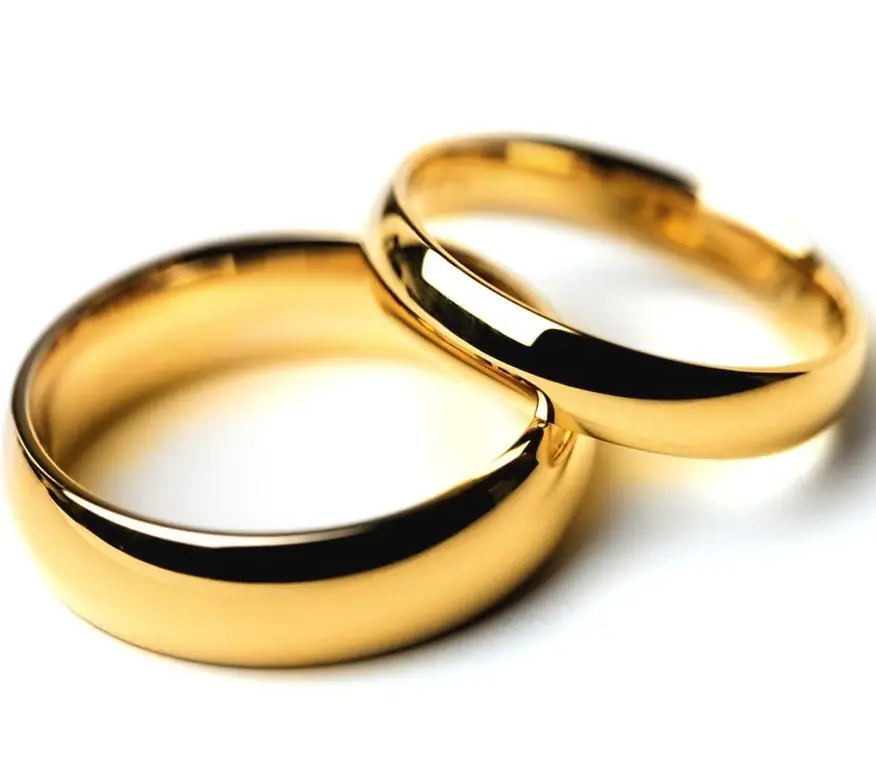
The “Save and Save” ring should be worn on the right hand,which the believer is usually baptized. Therefore, you need to put it on one of the three fingers participating in the banner of the cross (index, middle or large). But wedding rings should only be worn on the ring ring, as there is a belief that there is a vein going from the heart.
Home charms
Icons, like other church talismans, in Orthodoxy are not considered objects that can protect a person from evil spirits. Therefore, a believer should not consider them as amulets, because such an attitude can defile the images of the saints. Icons are designed to ask God and his faithful servants for help or intercession.
Despite the official opinion of religion, millions of people believe that icons protect their home from universal evil or bad slander. They say that their correct creation should be accompanied by the strictest fasting and prayers. Icons are Orthodox amulets at home, but without strong faith, they will be just beautiful paintings decorating the walls. The most powerful and revered of them is the “Protection of the Most Holy Theotokos”, because she is able to protect the one who asks from damage, the evil eye, and diseases. In addition, the icon can contribute to good luck in all endeavors or even in studies. It will not be superfluous to carry a small icon everywhere with you in order to always be under the protection of the Virgin.
Christian tattoos - mascots
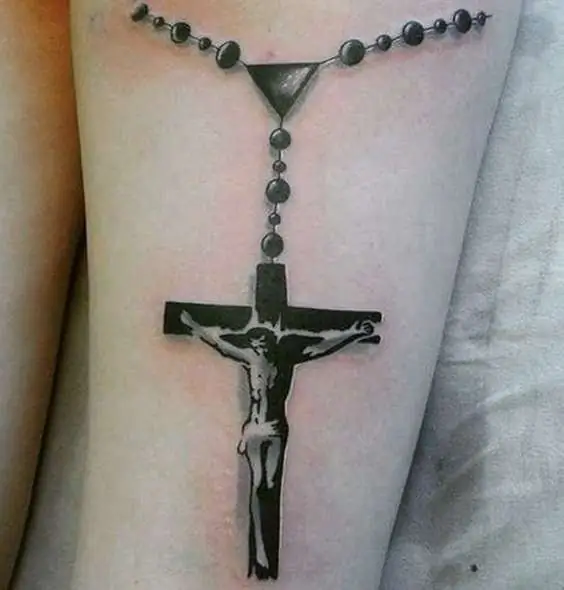
In the modern world, the application of the faces of saints or other religious symbols on the skin is gaining more and more popularity. Here is a list of orthodoxamulets-tattoo, which are the most in demand in modern society:
- cross;
- images of the great martyrs;
- words of prayers;
- other Orthodox symbols (rose, Latin cross, dove, anchor and Jerusalem cross).
For a long time, convicted Russian people have tattooed themselves with Christian themes. For example, crosses symbolized cleansing from sins, and the number of domes on the body was directly proportional to the years of imprisonment.
You may not believe in the miraculous power of Orthodox relics, but to completely deny it is at least stupid. Who are we to know 100% what was before us or will be after our death?






